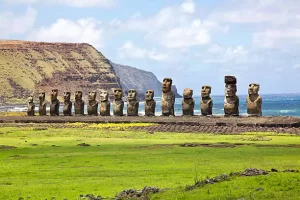Easter Island, or Rapa Nui as it’s known locally, is one of the most remote inhabited islands in the world and a place of profound cultural and historical significance. Famous for its mysterious moai statues, stunning landscapes, and rich Polynesian heritage, this small island in the Pacific Ocean is a dream destination for adventurers, history buffs, and nature lovers alike.
Essential Information
- Location: Southeastern Pacific Ocean, approximately 3,700 km (2,300 miles) west of mainland Chile.
- Language: Spanish and Rapa Nui
- Currency: Chilean Peso (CLP)
- Time Zone: Chile Standard Time (GMT-6)
- Climate: Tropical, with warm temperatures year-round. February is the hottest month, and July is the coolest.
- Best Time to Visit: October to April for warm weather, with February being especially vibrant due to the annual Tapati Festival.
Interesting Facts About Easter Island
- Easter Island is home to nearly 900 moai statues, some standing over 10 meters (33 feet) tall.
- The island was named by Dutch explorer Jacob Roggeveen, who landed there on Easter Sunday in 1722.
- Rapa Nui is a UNESCO World Heritage Site and part of Chile since 1888.
- The island is triangular, covering just 164 square kilometers (63 square miles).
- The mysterious rongorongo script, found on wooden tablets, remains undeciphered to this day.
How to Get There
- By Air: The only way to reach Easter Island is by plane. LATAM Airlines operates regular flights from Santiago, Chile (approximately 5.5 hours), and occasional flights from Papeete, Tahiti.
- Entry Requirements: All visitors must present proof of accommodations and a return ticket upon arrival. Additionally, travelers must pay the national park entrance fee to explore the island’s archeological sites.
Best Things to Do
- Explore the Moai Statues:
- Visit iconic sites like Rano Raraku, the quarry where the statues were carved, and Ahu Tongariki, home to 15 restored moai.
- Rano Kau and Orongo Village:
- Discover the ceremonial village of Orongo and gaze into the crater of the extinct Rano Kau volcano.
- Anakena Beach:
- Relax on this picturesque white-sand beach, framed by coconut palms and moai statues.
- Sunrise at Ahu Tongariki:
- Witness the magical sunrise behind the row of moai at this iconic site.
- Hiking and Trekking:
- Trails like Terevaka offer panoramic views of the island and the surrounding ocean.
- Tapati Festival:
- If visiting in February, immerse yourself in traditional Polynesian music, dance, and games during this vibrant festival.
Best Accommodation Options
- Luxury:
- Hangaroa Eco Village & Spa: A 5-star resort blending modern comforts with sustainable design.
- Explora Rapa Nui: Known for its all-inclusive packages, guided tours, and stunning architecture.
- Mid-Range:
- Hotel Hare Noi Rapa Nui: Offers comfortable bungalows and local hospitality.
- Taura’a Hotel: A family-run property with personalized service and an ideal location in Hanga Roa.
- Budget:
- Camping Mihinoa: Affordable and scenic, with options for tents or dormitory-style accommodations.
- Hostal Petero Atamu: A simple guesthouse with a friendly atmosphere.
Good Attractions
- Ahu Akivi: One of the few moai sites where the statues face the ocean.
- Puna Pau: A red scoria quarry used to carve the topknots (pukao) for the moai.
- Te Pito o Te Henua: Known as the “Navel of the World,” this sacred stone is said to have magnetic properties.
- Museo Antropológico Padre Sebastián Englert: A museum showcasing Rapa Nui culture and history.
Getting Around
- Car Rentals: Renting a car or scooter is the most convenient way to explore the island.
- Bikes and ATVs: For a slower pace, bicycles or ATVs are excellent options for navigating Easter Island’s roads.
- Guided Tours: Many visitors opt for guided tours to gain insight into the island’s history and cultural significance.
- On Foot: Hanga Roa and nearby sites are walkable, but some attractions are too far to reach on foot.
Day Trips
Easter Island is compact, so most activities can be done as part of your daily exploration. However, consider these specific excursions:
- Full-Day Archeological Tour: Covers major moai sites, including Ahu Tongariki, Rano Raraku, and Anakena Beach.
- Terevaka Hike: Trek to the island’s highest point for 360-degree views.
- Sunset at Tahai: A perfect spot to end the day, watching the sun dip behind moai statues.
Practical Tips
- Pack Light: The island’s remote location means limited access to goods; pack essentials like sunscreen, sturdy shoes, and a reusable water bottle.
- Respect the Heritage: Avoid touching or climbing on the moai statues and follow park guidelines.
- Currency and Payment: While many establishments accept credit cards, having cash is advisable for smaller vendors and tips.
- Wi-Fi and Connectivity: Internet access can be slow and limited; embrace the opportunity to unplug.
- Eco-Friendly Practices: Support local efforts to preserve the environment by minimizing waste and respecting wildlife.
Conclusion
Easter Island is a once-in-a-lifetime destination that offers a fascinating glimpse into an ancient and mysterious culture. From the enigmatic moai statues to its unspoiled landscapes, this remote island invites you to disconnect from the modern world and connect with history and nature. Whether you’re exploring volcanic craters, relaxing on pristine beaches, or delving into Rapa Nui traditions, Easter Island promises an unforgettable journey.
Start planning your adventure to this extraordinary corner of the world today!

